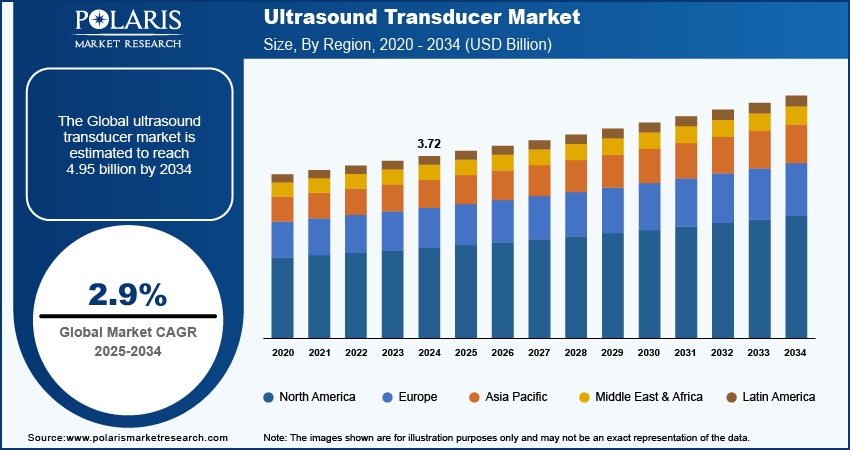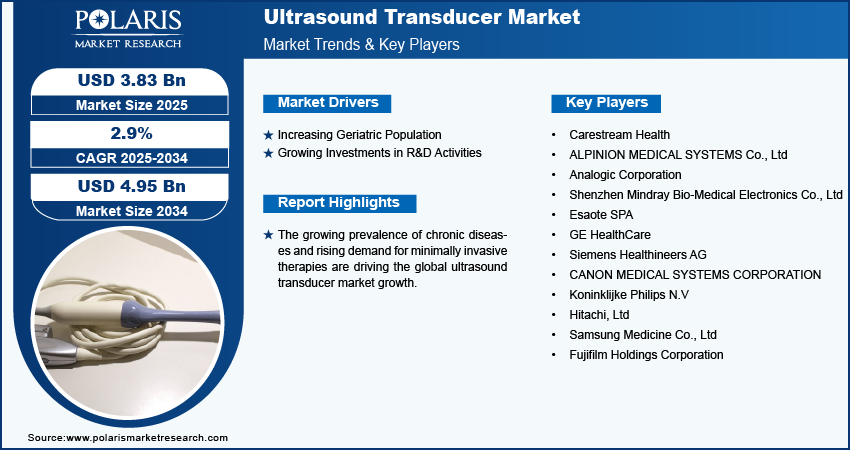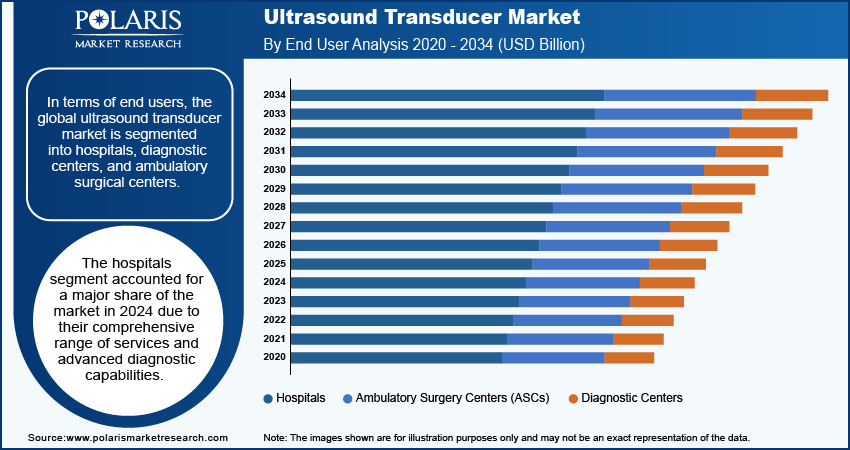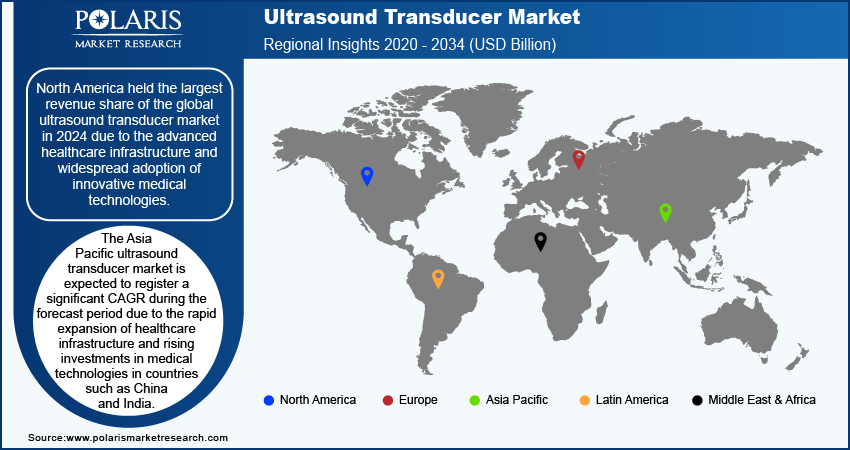
Ultrasound Transducer Market Size, Share, Trends, Industry Analysis Report: By Product Type (Convex, Linear, Endocavitary, Phased Array, CW Doppler, and Other), Application, End User, and Region (North America, Europe, Asia Pacific, Latin America, and Middle East & Africa) – Market Forecast, 2025–2034
- Published Date:Nov-2024
- Pages: 126
- Format: PDF
- Report ID: PM5198
- Base Year: 2024
- Historical Data: 2020-2023
Ultrasound Transducer Market Overview
The ultrasound transducer market size was valued at USD 3.72 billion in 2024. The market is projected to grow from USD 3.83 billion in 2025 to USD 4.95 billion by 2034, exhibiting a CAGR of 2.9% during 2025–2034.
An ultrasound transducer, also known as a probe, is a crucial component of ultrasound imaging systems. It serves the dual purpose of generating ultrasound waves and receiving the echoes that bounce back from tissues, enabling the creation of images for diagnostic purposes.
The rising demand for minimally invasive therapies is driving the global ultrasound transducer market growth. Ultrasound transducers are widely used in minimally invasive therapies as they provide real-time imaging, which enhances safety and reduces the risk of complications. Additionally, the growing prevalence of chronic diseases worldwide is expanding the global market. Approximately one in three of all adults suffer from multiple chronic conditions (MCCs) globally. Many chronic conditions, including heart diseases and cancer, necessitate therapeutic interventions, such as biopsies or injections. Ultrasound transducers are essential tools for these procedures, facilitating early detection and ongoing assessment.

To Understand More About this Research: Request a Free Sample Report
The increasing technological advancements in transducers would propel the ultrasound transducer market growth during the forecast period. Innovations have expanded the applications of ultrasound transducers, allowing them to be used in various fields, such as obstetrics, cardiology, and musculoskeletal imaging. This versatility increases their demand across multiple medical specialties.
Ultrasound Transducer Market Driver Analysis
Increasing Geriatric Population
The ultrasound transducer market growth is driven by the increasing geriatric population across the globe. According to the World Health Organization, the world's population of people aged 60 years and above is estimated to double by 2050. Older adults are more prone to chronic diseases such as heart disease, diabetes, and cancer. Ultrasound is a valuable tool for diagnosing and monitoring these conditions, driving demand for transducers as they are crucial components of ultrasound procedures for sound wave generation and image formation.
Growing Investments in R&D Activities
Increased R&D funding leads to the development of advanced transducer technologies, such as higher-resolution imaging, improved sensitivity, and enhanced portability. These innovations drive healthcare providers to upgrade their equipment, increasing demand. Therefore, growing investments in R&D activities propel the global ultrasound transducer market growth.

Ultrasound Transducer Market Segment Analysis
Ultrasound Transducer Market Breakdown By Product Type
Based on product type, the global ultrasound transducer market is segmented into convex, linear, endocavitary, phased array, CW Doppler, and others. The convex segment dominated the market in 2024 due to its versatility and effectiveness in various clinical applications. Convex transducers excel in abdominal imaging owing to their wide footprint and curved design, allowing for better penetration of sound waves into deeper tissues. This makes them particularly valuable in obstetrics, where they provide comprehensive views of fetal development. The growing prevalence of chronic diseases, particularly in aging populations, has increased the demand for abdominal assessments, further propelling the popularity of convex devices. Additionally, advancements in technology have enhanced the imaging quality of convex transducers, contributing to their position as a preferred choice among healthcare providers.
Ultrasound Transducer Market Breakdown By End User
In terms of end users, the global ultrasound transducer market is categorized into hospitals, diagnostic centers, and ambulatory surgical centers. The hospitals segment accounted for a major share of the market in 2024 due to their comprehensive range of services and advanced diagnostic capabilities. Hospitals serve as critical hubs for patient care, offering a wide range of medical procedures that rely on imaging technology. The increasing prevalence of chronic conditions has driven demand for diagnostic imaging services within these facilities. Hospitals provide immediate access to imaging services, allowing for rapid decision-making in emergencies and routine assessments alike.
The ambulatory surgical centers segment is estimated to grow at a rapid pace during the forecast period owing to the trend toward outpatient procedures and the emphasis on minimally invasive surgeries. These facilities are increasingly adopting imaging technologies to enhance their capabilities and improve patient care. Ambulatory surgical centers provide a cost-effective alternative to traditional hospital settings, attracting patients who prefer shorter wait times and personalized care. This positions ambulatory surgical centers as key healthcare facilities in the evolving healthcare environment.

Ultrasound Transducer Market Regional Insights
By region, the study provides the ultrasound transducer market insights into North America, Europe, Asia Pacific, Latin America, and the Middle East & Africa. North America held the largest revenue share of the global market in 2024 due to the advanced healthcare infrastructure, widespread adoption of innovative medical technologies, and a high prevalence of chronic diseases that necessitate frequent imaging. The strong emphasis on research and development within the US healthcare system has fostered innovations that enhance imaging quality and accessibility. Additionally, the increasing focus on preventive healthcare and early diagnosis fuels demand for ultrasound transducers, as healthcare providers aim to improve patient outcomes through timely and accurate assessments.
The Asia Pacific ultrasound transducer market is expected to register a significant CAGR during the forecast period due to the rapid expansion of healthcare infrastructure and rising investments in medical technologies in countries such as China and India. Governments of Asia Pacific are actively promoting initiatives to improve healthcare accessibility, which includes expanding imaging capabilities in urban and rural areas. This enhances the usage of ultrasound, which ultimately leads to a high demand for ultrasound transducers as they are key components of ultrasound. Moreover, a growing middle-class population, increasing awareness of healthcare options, and rising prevalence of chronic diseases contribute to the high demand for ultrasound transducers. For instance, the burden of chronic diseases in Asia has increased in recent years, accounting for 70–77% of all deaths between 2010 and 2019.

Ultrasound Transducer Market – Key Players and Competitive Insights
Prominent market players are investing heavily in research and development to expand their offerings, which will boost the ultrasound transducer market growth in the coming years. Market participants are also undertaking a variety of strategic activities to expand their global footprint, with important market developments such as innovative launches, international collaborations, higher investments, and mergers and acquisitions between organizations. To expand and survive in a more competitive and rising market environment, the ultrasound transducer industry players must offer innovative solutions.
The ultrasound transducer market is fragmented, with the presence of numerous global and regional market players. A few major market players are Carestream Health; ALPINION MEDICAL SYSTEMS Co., Ltd; Analogic Corporation; Shenzhen Mindray Bio-Medical Electronics Co., Ltd; Esaote SPA; GE HealthCare; Siemens Healthineers AG; CANON MEDICAL SYSTEMS CORPORATION; Koninklijke Philips N.V; Hitachi, Ltd; Samsung Medicine Co., Ltd; and Fujifilm Holdings Corporation.
GE Healthcare is a global medical technology and pharmaceutical diagnostics company headquartered in Chicago, Illinois. It operates as a subsidiary of General Electric and was officially announced as an independent entity on January 4, 2023. The company specializes in developing and distributing a wide range of medical imaging equipment and healthcare solutions. GE Healthcare offers a comprehensive portfolio of ultrasound transducers designed for a wide range of clinical applications. These transducers are compatible with GE's ultrasound systems and feature advanced technologies for enhanced image quality and diagnostic capabilities. In August 2023, GE HealthCare announced the launch of Vscan Air SL, a wireless handheld ultrasound device for the assessments of vascular and cardiac patients.
Koninklijke Philips N.V., commonly known as Philips, is a multinational conglomerate corporation that was founded in 1891. The company is headquartered in Amsterdam. It offers a wide range of ultrasound transducers designed to deliver high-quality images across various clinical applications. Their transducers feature innovative technologies such as PureWave and XDClear to enhance image quality, penetration, and resolution. In November 2022, Koninklijke Philips N.V. launched a next-generation compact portable ultrasound solution at the Radiological Society of North America (RSNA) annual meeting to facilitate first-time-right ultrasound exams for more patients.
Key Companies in Ultrasound Transducer Industry Outlook
- Carestream Health
- ALPINION MEDICAL SYSTEMS Co., Ltd
- Analogic Corporation
- Shenzhen Mindray Bio-Medical Electronics Co., Ltd
- Esaote SPA
- GE HealthCare
- Siemens Healthineers AG
- CANON MEDICAL SYSTEMS CORPORATION
- Koninklijke Philips N.V
- Hitachi, Ltd
- Samsung Medicine Co., Ltd
- Fujifilm Holdings Corporation
Ultrasound Transducer Industry Developments
January 2024: Koninklijke Philips N.V., a health technology company, announced that its latest TEE transducer, designed to serve more patients with improved overall comfort, had received FDA 510(k) clearance.
January 2023: Fujilfim Sonosite, Inc., a part of Fujifilm Holdings Corporation, announced the launch of the new Sonosite PX ultrasound system. Sonosite PX is the next generation in Sonosite POCUS, with the most advanced image clarity ever seen in a Sonosite system.
July 2022: Siemens Healthineers AG, a global medical technology company, launched 12 new transducers in the portfolio for four ultrasound systems.
Ultrasound Transducer Market Segmentation
By Product Type Outlook (Revenue, USD Billion, 2020–2034)
- Convex
- Linear
- Endocavitary
- Phased Array
- CW Doppler
- Other
By Application Outlook (Revenue, USD Billion, 2020–2034)
- Cardiovascular
- General Imaging
- Musculoskeletal
- OB/GYN
- Vascular
- Others
By End User Outlook (Revenue, USD Billion, 2020–2034)
- Hospitals
- Diagnostic Centers
- Ambulatory Surgical Centers
By Regional Outlook (Revenue, USD Billion, 2020–2034)
- North America
- US
- Canada
- Europe
- Germany
- France
- UK
- Italy
- Spain
- Netherlands
- Russia
- Rest of Europe
- Asia Pacific
- China
- Japan
- India
- Malaysia
- South Korea
- Indonesia
- Australia
- Rest of Asia Pacific
- Middle East & Africa
- Saudi Arabia
- UAE
- Israel
- South Africa
- Rest of Middle East & Africa
- Latin America
- Mexico
- Brazil
- Argentina
- Rest of Latin America
Ultrasound Transducer Report Scope:
|
Report Attributes |
Details |
|
Market Size Value in 2024 |
USD 3.72 Billion |
|
Market Size Value in 2025 |
USD 3.83 Billion |
|
Revenue Forecast by 2034 |
USD 4.95 Billion |
|
CAGR |
2.9 % from 2025 to 2034 |
|
Base Year |
2024 |
|
Historical Data |
2020–2023 |
|
Forecast Period |
2025–2034 |
|
Quantitative Units |
Revenue in USD Billion and CAGR from 2025 to 2034 |
|
Report Coverage |
Revenue Forecast, Market Competitive Landscape, Growth Factors, and Trends |
|
Segments Covered |
|
|
Regional Scope |
|
|
Competitive Landscape |
|
|
Report Format |
|
|
Customization |
Report customization as per your requirements with respect to countries, regions, and segmentation. |
FAQ's
The global ultrasound transducer market size was valued at USD 3.72 billion in 2024 and is projected to grow to USD 4.95 billion by 2034.
The global market is projected to register a CAGR of 2.9% during the forecast period.
North America accounted for the largest share of the global market in 2024.
A few key players in the market are Carestream Health; ALPINION MEDICAL SYSTEMS Co., Ltd; Analogic Corporation; Shenzhen Mindray Bio-Medical Electronics Co., Ltd; Esaote SPA; GE HealthCare; Siemens Healthineers AG; CANON MEDICAL SYSTEMS CORPORATION; Koninklijke Philips N.V; Hitachi, Ltd; Samsung Medicine Co., Ltd; and Fujifilm Holdings Corporation
The other segment is projected for significant growth in the global market during the forecast period.
The hospital segment dominated the market in 2024.
